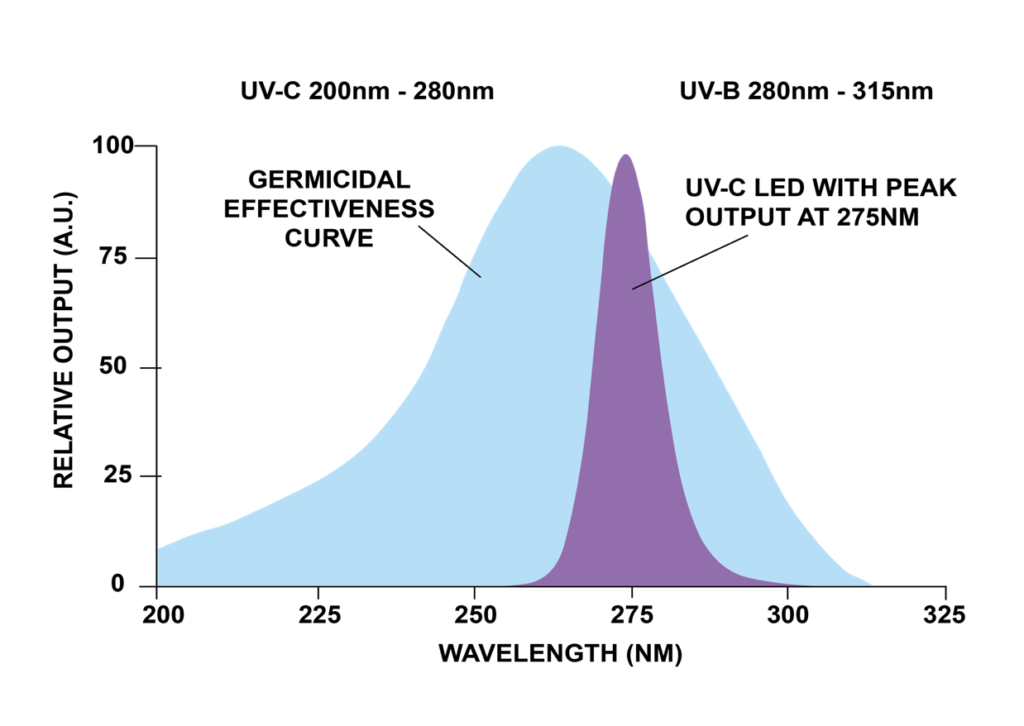
The pandemic has been especially difficult for isolated, aging populations. As vulnerable, high-risk senior living communities resume normal day-to-day operations, sustainable, science-backed solutions have become an imperative.
In the end, vaccinations and masks aren’t enough to ensure safety given the rise of variant cases nationwide. Operators must proactively supplement their COVID-19 protocols to not only protect their constituents but also help them overcome increasing fears and anxieties. UVC light fixtures can offer peace of mind and a way forward.
Evaluating UV-C Light products
In the wake of COVID-19, “germicidal UVC” has become a popular topic, gaining recognition as one of the best options for removing pathogens from indoor air, and for good reason. Backed by decades of scientific research, UVC light is proven to eradicate dangerous pathogens through exposure to specific wavelengths of UVC light (200 nm to 280 nm), which inactivates virus particles and stops them from replicating.
In an oversaturated market, various products promise the power of germicidal UVC light, but not all systems are equal. UVC light products range from fixtures that only operate during unoccupied hours to fixtures that are designed to operate when people are present. So, how do senior living communities determine which UVC air cleaning system is most effective for their needs? A UVC product should be assessed by:

- Power of UVC wavelength: UV light covers a wavelength spectrum from 100 to 380 nm and is further subdivided into UVA (320 to 400 nm), UVB (280 to 320 nm) and UVC (100 to 280 nm). Although UVC has the most potent germicidal effect, its higher nanometer wavelength does not correlate to strength. Studies have proven that 275 nm is optimal for germicidal effectiveness, as illustrated by the accompanying chart.
- Duration of UVC LED exposure and air circulation: Per COVID-19 protocol, the Centers for Disease and Control recommends multiple air changes per hour in occupied, indoor areas. But not every UVC light fixture offers the duality of air circulation, with manufacturers opting instead to depend on an indoor space’s air circulation, such as from their HVAC system. However, HVAC systems cannot ensure airflow quantity or the UVC exposure time, and that often results in stagnant and infected air remaining in the space. The best UVC solutions have the duality of UVC light and added air circulation, pulling air up and away from the most critical air in the room, the air people are breathing right now, to be most effective.
- Verifiable lab results: 99% versus 99.99%: Any UVC solution worth considering should pass rigorous lab testing, with aerosolized SARS-CoV-2 virus (the cause of COVID-19) at an accredited national Level 3 bio lab with certified results. Unfortunately, not every vendor is transparent about its testing results. The true measure of any UVC system’s effectiveness lies in its preventive protection and subsequent lack of infections. Some UVC solutions claim a 99% effective rate, and others purport a 99.99% rate at killing viruses. Although the decimal place seems trivial, there is a big difference between 99% and 99.99% scientifically (both mean that there is a fraction of unclean air and, therefore, the risk of infection remains). With vulnerable populations, that difference matters. Verify a system’s effectiveness with its lab results and aim for as close to 100% as possible.
- Product lifespan and maintenance costs: Most UVC solutions today use mercury-vapor bulbs to produce 254 nm UVC light. Those bulbs have a useful life of 6 to 12 months, depending on usage hours, then need to be replaced. Over a typical five- to 10-year lifespan, budgets also should account for bulb replacement costs (often hundreds of dollars each), installation, proper bulb disposal and additional maintenance fees. Newer UVC light solutions based on UVC LED chips (275 nm), however, last seven to 10 years with regular use and are better for the environment.
Act proactively to save lives
Although real-time threats are invisible in daily life, UVC LED solutions prevent and protect senior living communities against airborne pathogens. Adoption undoubtedly will save lives, and the best testament of their effectiveness is a healthy, thriving community that is unfazed by the pandemic’s cycles.
Steve Daniel is the president of UV Health Group, a Portland, OR-based designer and manufacturer of antimicrobial energy-efficient UV-C LED products for cleaning air in rooms when people are present. He has been designing and deploying UV-C light systems for commercial spaces and agriculture industries for the past five years.
The opinions expressed in each McKnight’s Senior Living marketplace column are those of the author and are not necessarily those of McKnight’s Senior Living.


